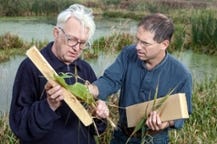It's not often that new plastic materials are developed, let alone a new family. Now, over the past three months, not one, but two research institutes have actually gone and done both, according to the reports. At IBM Research, scientists have discovered a new family of thermoset materials that are extremely strong, light, chemically recyclable and even self-healing, depending on the conditions and the diamine monomer used to make them.
May 21, 2014
It's not often that new plastic materials are developed, let alone a new family. Now, over the past three months, not one, but two research institutes have actually gone and done both, according to the reports. At IBM Research, scientists have discovered a new family of thermoset materials that are extremely strong, light, chemically recyclable and even self-healing, depending on the conditions and the diamine monomer used to make them. PlasticsToday's Clare Goldsberry provides more details about that discovery in her article entitled IBM Research discovers new class of industrial polymers.
Across the ocean, however, material scientists received another shock: researchers at the University of Amsterdam's Van 't Hoff Institute for Molecular Sciences (HIMS), who had previously announced the development of what they claim is the world's first biobased, biodegradable thermosetting polymer, have now released more details about their new material, which they have named glycix.
|
Researchers Albert Alberts and Gadi Rothenberg. |
As researchers Gadi Rothenberg and Albert Alberts tell it, they were looking for a biofuel and developed a bioplastic: a "once in a lifetime event," is how they describe their discovery, which, surprisingly, they initially made in 2011. However, as the patent was only just granted on the new thermoset material, they were unwilling to reveal any information about it until last week, when they presented a table made of glycix to the board of the University of Amsterdam.
As these two researchers explained, the thing about thermoset plastics is that when heated, undergo a chemical as well as a phase change. Thermoset plastics contain polymers that cross-link together during the curing process to form an irreversible chemical bond. Once cured, therefore, they cannot be melted or remolded. Their tightly crosslinked structure means that they are tough, durable, provide good dimensional stability and are better able to resist higher temperatures than most thermoplastics. But unlike most thermoplastics, these materials cannot be recycled, and thus tend to end up being incinerated or landfilled.
Glycix, however is 100% biodegradable, a property that up until now was reserved for thermoplastic materials. It is a polyester, the basic ingredients of which are glycerol and citric acid, two substances in abundant supply that can be produced from biomass. It will not only degrade in soil, but also in water. "Our plastics will disappear into nature all by themselves, every bit of them will be decomposed into vegetal materials," says Rothenberg.
In water, the material chemically decomposes into the monomers glycerol and citric acid. "These are two compounds which are completely natural and will be absorbed in the natural cycle," says Rothenberg. "The decomposition rate depends on the degree to which the plastic has been hardened. Decomposition time varies from several weeks to a year, depending on the production method."
Because it decomposes in contact with water, the material is unsuitable for outdoor applications. For this reason, the table presented to the university board was covered with a glass tabletop to protect it from spills.
The researchers were disclosing no further details about the material as additional patents are still pending, except to say that glycix is easily processable, and that it can be injection molded without any problem. Apparently, it also adheres well to other materials and can therefore be used in combination with stainless steel, glass and other materials. However, processing and product development is still a long way down the road.
As the researchers point out: "Further development will take years, patent procedures by themselves last several years."
Nonetheless, they see a bright future for the new polymer.
"Our plastic is going to change the world," says Rothenberg. "Industry is very interested already." And would that be chemical industry or consumer goods manufacturers? "Let us just say that industry is very interested."
About the Author(s)
You May Also Like



